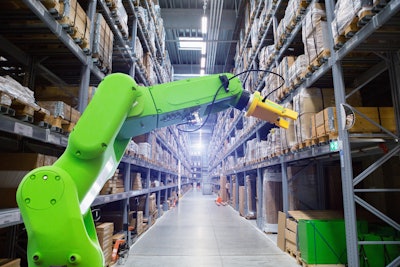
United States manufacturing growth hit an 11-month low in December 2021 as global pandemic-fueled supply chain issues continued to plague manufacturers — ranging from transportation backups to the surging prices of raw materials. And economists warn that growth could slow down even further in the coming months due to the omicron strain of COVID-19 and future variants.
With the supply chain in constant crisis over the past two years and a pessimistic outlook of the year ahead, manufacturers need every advantage they can get to combat delays, optimize deadlines, and achieve higher production.
Fortunately, the Industrial Internet of Things (IIoT) offers several advantages to counteract supply chain issues. This “smart” technology’s use of data, artificial intelligence (AI), predictive analytics, and automation fuels greater agility, better decision-making, and improved cost-efficiency. The manufacturers that thrive will take advantage of the potential $1.2 trillion to 3.7 trillion in value that IIoT is predicted to generate for factories alone.
What is the (Industrial) Internet of Things?
The Internet of Things (IoT) refers to physical objects embedded with computing devices that ingest, send, and receive data with other IoT and non-IoT devices and systems. Technologies like wireless sensors, control systems, automation, and AI enable IoT devices to operate independently of human control and adjust to any number of conditions.
IoT devices have skyrocketed in popularity in the consumer space, with two-thirds of North American households now owning at least one smart device, like a smart thermostat that manages the temperature of one’s home. However, McKinsey estimates the majority of the trillions in potential value IoT could generate in the next decade will come from B2B solutions and applications, like smart factories and smart cities.
Industrial IoT is a subset of IoT that’s used in manufacturing and other sectors like healthcare, utilities, and aviation. Unlike consumer-based counterparts, IIoT uses information technology (IT) and operational technology (OT), which provide better visibility into processes and stronger system integrations. Given the crucial applications of IIoT — from regulating the pressure of underwater oil pipelines to producing life-saving equipment — the technologies’ sensors are much more powerful and play a more significant role than in consumer-based IoT.
To illustrate IIoT in action, consider a smart assembly line where multiple pieces of equipment work together to build products. Sensors ensure production happens at the right speed and can automatically adjust as needed, without human oversight. The smart assembly line can provide insight into metrics like production efficiency and output, raw material waste, and equipment's overall effectiveness.
Ultimately, IIoT helps manufacturers further automate tasks and adjust to any number of conditions as needed, freeing up human time. With improved visibility into operations and production processes, manufacturers can find opportunities for greater efficiency. These advantages can help manufacturers react to and overcome changes in the supply chain in real-time.
Three ways IIoT can help you adapt to supply chain issues
IIoT can help alleviate supply chain issues and provide full transparency so you can make up for delays with increased efficiency. Applications of IIoT technology for the supply chain include:
- Tracking assets — Given the unpredictability of shipping and transportation, knowing the exact location of materials and products can help you better plan production. IIoT battery-less network tags can be placed in shipping containers, pallets, individual orders, or any other collection of goods. These tags connect to a network, sending real-time updates on the location of an asset and its surrounding environmental conditions (like humidity).
IIoT asset tracking can help you easily track down misplaced items within your facilities. Overall, IIoT asset tracking gives better visibility into inventory, which is key to minimizing delays and maintaining an accurate picture of work in progress. - Optimize materials and production — With the costs of raw materials skyrocketing, avoiding scrap and botched production loads becomes more critical to your bottom line. IIoT technology can help in many ways. First, if materials are sensitive to environmental conditions (say temperature), you can adopt smart storage units that maintain optimal storage conditions. Similarly, climate sensors can adapt IIoT machines to ensure production quality stays within required parameters if your production line is weather-dependent. Finally, smart cameras can check the quality of inbound raw materials to ensure they’re handled properly.
All of these applications are automated, meaning workers no longer have to quality check raw materials or adjust storage settings and production lines. This allows employees to focus on higher priority projects or employers to reduce headcount. Another benefit of IIoT technologies is additional visibility into scrap and production effectiveness, helping uncover opportunities to reduce waste and increase efficiency. - Reduce stoppages — IIoT sensors, predictive analytics, and digital twin technology helps you predict the lifecycle of machines so you can avoid work stoppages. The use of a digital twin — essentially a digital recreation of a physical asset — allows users to understand how their IIoT equipment operates when at optimal conditions. Then, AI programs continuously monitor live data to detect anomalies in the physical machinery. This concept, known as predictive maintenance, allows you to proactively service machines to prevent breakdowns that delay production and identify areas where you can increase the efficiency and life expectancy of physical assets.
To showcase an example of this in action, look to VEM, an electric engine manufacturer. VEM creates and maintains digital twins for every engine it sells to identify opportunities for innovation. Each engine has an IoT module that measures its operating state, enabling VEM to identify any issues and determine whether it's an isolated incident. The manufacturer allows its customers to access their specific engine measurements as a service, providing VEM with an additional source of revenue.
It’s time to embrace the supply chain of the future
While IIoT has incredible potential, be forewarned: The value of insights provided by IIoT is only as good as your data infrastructure. So, alongside your IIoT investment, ensure your data store and infrastructure are sophisticated enough — otherwise, your ability to ingest, process, analyze, transform, and use information will be limited. Major public cloud platforms such as AWS, Microsoft Azure, and Oracle Cloud Infrastructure all have IoT solutions that can run natively on their platforms.
While cost and limited IIoT providers may have been a deterrent five years ago, today IIoT technology is widely accessible with hundreds of companies offering solutions for every price point. Given the incredible usefulness of IIoT to predict, mitigate and adjust to disruptions in the supply chain before they become crises, the question now is: Can you afford not to adopt IIoT?



















